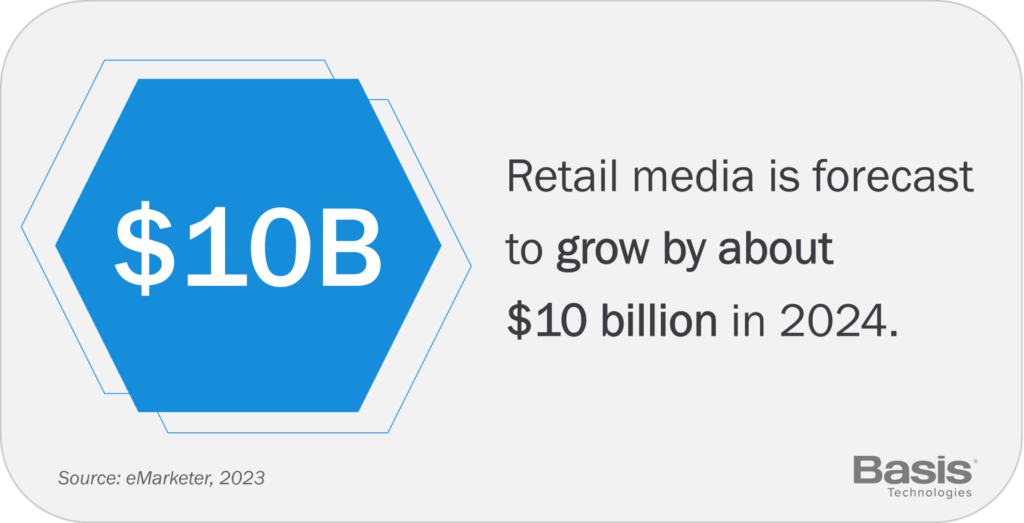
During the early stages of the pandemic, consumer shopping behaviors migrated online out of necessity and convenience. Today, while pandemic restrictions have loosened and in-store shopping has now rebounded in some areas, e-commerce is still on the up-and-up across nearly all retail categories. The online retail and e-commerce space has truly come into its own, with consumers increasingly shopping websites and apps for items ranging from luxuries to necessities.
As part of this online shopping boom, and in preparation for cookie loss, retailers are learning how to collect more first-party data from customers through promotions and loyalty programs. This, in turn, is resulting in new opportunities to monetize, analyze, and diversify how they activate this wealth of valuable customer information to drive both online and in-store sales.
Meanwhile, technology has continued its rapid advance: Artificial intelligence, which is forecast to grow globally in retail market size from $10 billion to $45 billion in the next decade, is powering retail data analysis and subsequent recommendation engines. At the same time, consumers’ screens, big and small, are becoming more interactive, actionable, and attributable to sales in real time.
Looking to make the most of all the new opportunities available to retail marketers in 2024? Read on for three key trends:
If first-party data is gold for marketers, then retailers and e-commerce brands that successfully collect and activate that data can be considered retail royalty. And retail media networks (RMNs)? They’ve quickly created a kingdom of their own. In fact, it was that inherent value of first-party data—opt-in, great for targeting and attribution, and future-friendly in a cookieless world—that created a catalyst for the explosion of RMNs, which are forecast to reach $55 billion next year.

RMNs allow retailers to monetize first-party data by providing targeted, attributable advertising inventory on their websites and apps, as well as in stores. For instance, Walmart.com can activate a logged-in user's first-party data and analyze their shopping patterns to target them with relevant product ads to drive future sales. This could look like displaying ads for baby food to someone who purchased diapers, or showing a shopper who almost bought a certain sweater an ad for an alternate knitwear brand.
Right now, RMN data is very siloed and lacks standardization. This makes it difficult for advertisers to assess which networks are driving strong performance, incremental sales lift, and ROI across all their chosen RMNs, which hinders informed budget allocation. And the biggest players, like Walmart and Amazon, don’t have much incentive to share their data outside their own walls. So, it’s in the best interest of retailers and e-commerce businesses to take a balanced approach to the visibility of RMNs—remember, your own first-party data is king.
While certain aspects of artificial intelligence are still evolving, there are already numerous practical applications in use. These include personalization opportunities, customer service capabilities, and the ability to analyze data to forecast product demand.
As customers call for more personalized shopping experiences, AI will enable retailers and industry marketers to deliver on expectations in key ways. Data analysis will continue to improve as AI matures, and retailers and e-commerce marketers will consequently be able to utilize AI-powered tools to better segment and target audiences and tailor the advertising they see across the web.
Post-purchase, generative AI tools are evolving to be head and shoulders above previous iterations of simple chat-based customer support. Pairing owned data with GenAI can help retail marketers with tactics like targeted and relevant promotional messages based on past purchases, up-sells or re-sells (if a prior purchase is getting old), cross-sells (say, a deal on golf shoes for a customer who just bought a new driver), or creating content, talk tracks, and dynamic offers or webpages within a more controlled customer service environment. Of course, retail brands will want human team members to review content generated by AI to ensure accuracy and brand authenticity.
Shoppers have continued their shift to smaller screens—smartphones, tablets, and laptops. Still, with the growing addressability and connectedness of the large screens in our homes, retail marketers are increasingly able to advertise their goods cohesively across devices. Even better, those devices and platforms have evolved to let customers scan, click, or tap to shop directly from the ads they display.
There are many ways to create shoppable videos, including adding product links to video descriptions, using overlays to display product information, or displaying QR codes that link viewers to product pages. For example, QR codes in CTV advertising allow highly targeted consumers to navigate to retail or e-commerce sites, an action that can be directly attributed to the advertising campaign. It’s an opportunity to get the best of both worlds: the lean-back, immersive experience of traditional TV plus the granular targeting and measurement capabilities that come with digital advertising.
On smaller screens, platforms like Meta, TikTok, and YouTube are developing technologies that let consumers purchase products within videos on their platforms. This trend was accelerated in no small way by Apple’s App Tracking Transparency, which made it difficult for platforms to track user behavior outside their own ecosystems. Social media channels are rewarding retail advertisers with greater visibility for creating shoppable ads, as they keep users on the platforms, and they offer a chance to collect valuable user data from purchase activities—a win-win for platforms and for retail marketers.
Overall, as pandemic-era online shopping behaviors have maintained and evolved, competitive retailers and platforms have adapted to those behaviors in ways that turn data into dollars. Marketers in the retail and e-commerce industry who strategically tap into retail media networks, artificial intelligence, and shoppable video will meet customers where they are and how they expect to transact, in ways that foster sales and longer-term loyalty.
__
Hungry for more 2024 trends? Check out our 2024 Trends Report for everything digital marketers need to know for next year.